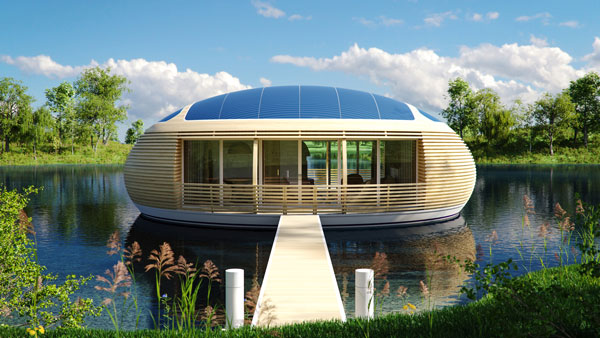Italian architect Giancarlo Zema’s new eco-friendly floating home is a domestic escape for those who want to live simply, surrounded by nature. Inspired by the aquatic nests of birds, the WaterNest 100 is a self-contained, 1,076-square-foot living space resembling a louvered, slightly flattened egg. The home is built from 98% recycled materials and powered by a rooftop solar array.
So what are the advantages of living on a floating house—other than, say, the great panoramic views? According to Sara Schutte, project manager at Giancarlo Zema Design Group, there are many, beginning with “the possibility to live in close contact with nature and be totally off-grid in a fluid and sensual environment that transmits tranquility, such as water does, as an innate memory of our growth in amniotic fluid.” Beyond that, Schutte says, “climate change will continue in the coming years, thereby increasing the water level of our oceans, seas, lakes, and rivers. Living in a floating manner protects us from this adversity.”
 This is not the first high-concept aquatic residence out of the Giancarlo Zema Design Group, an architecture practice based in Rome, which specializes in semi-submerged structures, marine parks, floating habitats, yachts, and interior design. Projects such as Trilobis 65, a residential yacht powered by hydrogen fuel cells, or the Jelly-fish 45, a floating home that provides underwater views, reflect the firm’s interest in biomorphic forms that blend organic design with technological sophistication.
This is not the first high-concept aquatic residence out of the Giancarlo Zema Design Group, an architecture practice based in Rome, which specializes in semi-submerged structures, marine parks, floating habitats, yachts, and interior design. Projects such as Trilobis 65, a residential yacht powered by hydrogen fuel cells, or the Jelly-fish 45, a floating home that provides underwater views, reflect the firm’s interest in biomorphic forms that blend organic design with technological sophistication.
Like those projects, the WaterNest is conceived as a model of ecological sensitivity. The $600,000-800,000 concept has elicited requests from various parts of the world, especially the United States, United Arab Emirates, Europe, and Australia.
Electricity is produced via a 60-square-meter amorphous solar array that has a peak output of 4kW, more than enough power to supply the 1.5kW of energy needed to operate the house. The roof’s rounded shape, aside from its visual elegance, accommodates bathroom and kitchen skylights and optimizes electricity generation by mirroring the arc of the sun. The terrace under the doors and along the windows is designed to allow in the low-angled light of the winter sun. In the summer, the brise-soleil at the highest point of the roof keeps the home shaded and cool.

 In addition, the home is sensitive to resource conservation. The WaterNest 100 uses laminated wood from controlled cultivations, Schutte says—no forest-clearing—and recycled timber. The hull is made of recycled aluminum, furnished by Italian companies, and the wood furniture—softly lined and modernist—is eco-friendly. In place of air conditioning, a micro-ventilation system allows fresh air to circulate upward from the hull through floor grilles, taking advantage of water immersion to cool the interior.
In addition, the home is sensitive to resource conservation. The WaterNest 100 uses laminated wood from controlled cultivations, Schutte says—no forest-clearing—and recycled timber. The hull is made of recycled aluminum, furnished by Italian companies, and the wood furniture—softly lined and modernist—is eco-friendly. In place of air conditioning, a micro-ventilation system allows fresh air to circulate upward from the hull through floor grilles, taking advantage of water immersion to cool the interior.
The WaterNest 100 is designed for use on rivers, lakes, bays, atolls, and calm seas, but its potential uses are open to the imagination. The interior can include a living room, dining area, bedroom, kitchen, and bathroom and accommodate up to a family of four. It’s also possible to configure as an office, lounge bar, restaurant, shop, or exhibition space.
EcoFloLife, which developed the WaterNest 100 based on Zema’s design, is now taking orders, Schutte says, and the first installation is nearly complete. “It will be ready very soon and the unveiling will be a big surprise. We are working on the development of an ecological Floating Village where WaterNests create a sustainable colony like a large solar station,” Schutte says.
Download a PDF of this story here.

